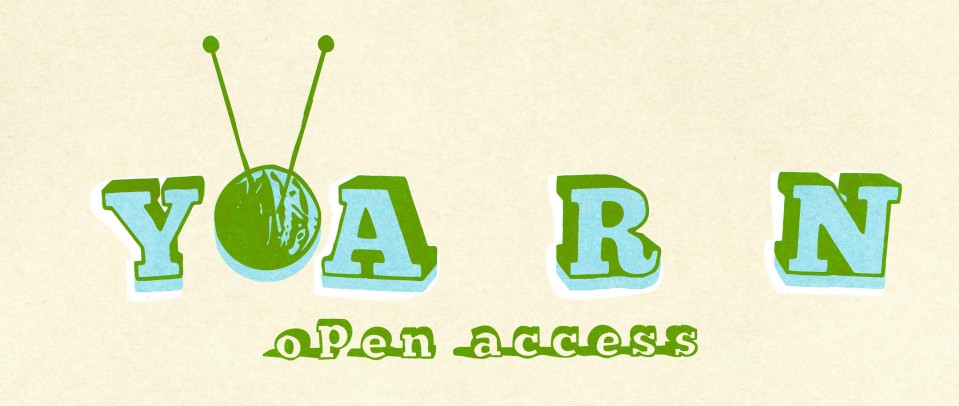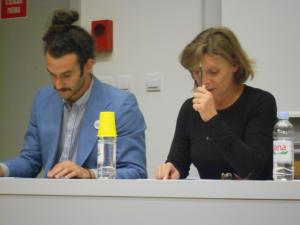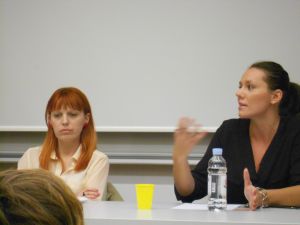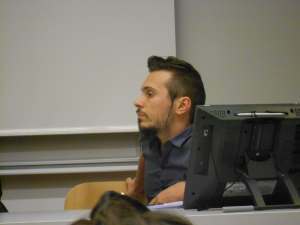Fair Chaos: What Happens After Open Access?
1October 29, 2012 by Katarina Lovrecic
Croatia celebrated Open Access Week in both Zagreb and Rijeka, this year. In Zagreb, a Croatian declaration to Open Access was presented, and in Rijeka, we decided for an open discussion on what authors will be like in the future, whether they will see a closed or an open scholarly system more fit for their webby research.
The invited speakers were Senka Tomljanović, the head of University Library in Rijeka, David Blažević, a young scientist, a junior researcher at the Faculty of Engineering in Rijeka, Sara Uhač, a PhD student at the University of Lugano in Switzerland, experienced in journal/open access publishing, and Kristina Posilović, an assistant professor and a member of a community of poets/writers who mash up their texts online. As our special guest, we welcomed Tomislav Medak from the Multimedia Institute in Zagreb, Croatia, previously a project leader of Croatian Creative Commons, a philosopher, and a member of the Zagreb based theatre company BADco.
The given theme of the table was the value of a street cred of scholars, picked up through social media such as Twitter, Facebook, or reference managers such as Mendeley and Zotero. Another theme was the creation of a living text online, the difference between an author and a reader, and the nature of their dialogue. Finally, considering this dialogue and the communication/interaction as the focus of writing, we were to answer the question whether authors will benefit from making their texts available online, for free.
What is impeding communication/interaction today? “The non-availability of relevant information,” David commented, “what is the value added by publishers who still keep the systems closed, or journals available at a price of 30 USD per article?” “Why won’t they let us buy kindle and iPads for libraries?” Senka asked. She, of course, mentioned the well known rise in journal prices, and the cuts made to the library budget. More and more, we choose to find relevant texts from libraries with pirated material, due to so many obstacles that university libraries face. Tomislav reminded that we keep confusing the author creation with the creation of “original author pieces.” He even warned of the recent “publish less” trend among authors and their mentors, in order to keep their reputation steady. “Who has the access to reputation,” that is the question we should ask. We all agreed that the ultimate goal should be to encourage the free flow of scientific information. Any system that pushes towards doing less or more slow, or more expensive – is not only impeding research, but acting as a schizoid filter, that breaks the thought process. “Our diagnosis is a mental disorder,” Kristina commented.
While inspecting cognition, the concept of cognitive capitalism was mentioned in the audience, a theory centered around the accumulation of immaterial assets protected through IP rights. “We are creating false dichotomy while asking whether we should make our works open access or not,” since “open access is obviously imminent.” Or, as Sara commented, “as far as the publishing industry is considered, it needs to adapt or die.” But, what happens after Open Access? Maybe we should focus on discussing the new value creation once we move to the production of knowledge as the production of – wealth. “The real reforms can only happen on a society level,” Tomislav reminded us, “and the only real instruments that we can use to achieve such reforms are institutions that dictate the social roles.” Or, government bodies? There, we should attempt at upsetting the (dis)order?
“Oh, and you know the thing about chaos? It’s fair!”
Joker, The Dark Knight
***
Credit
Photo: Silvia Vlaše, The Dark Knight reference: Marko Luka Zubčić




AFTER GRATIS GREEN OA COMES LIBRE GOLD OA
What the research community needs, urgently, is free online access (Open Access, OA) to its own peer-reviewed research output. Researchers can provide that in two ways: by publishing their articles in OA journals (Gold OA) or by continuing to publish in non-OA journals and self-archiving their final peer-reviewed drafts in their own OA Institutional Repositories (Green OA). OA self-archiving, once it is mandated by research institutions and funders, can reliably generate 100% Green OA. Gold OA requires journals to convert to OA publishing (which is not in the hands of the research community) and it also requires the funds to cover the Gold OA publication costs. With 100% Green OA, the research community’s access and impact problems are already solved. If and when 100% Green OA should cause significant cancellation pressure (no one knows whether or when that will happen, because OA Green grows anarchically, article by article, not journal by journal) then the cancellation pressure will cause cost-cutting, downsizing and eventually a leveraged transition to OA (Gold) publishing on the part of journals. As subscription revenues shrink, institutional windfall savings from cancellations grow. If and when journal subscriptions become unsustainable, per-article publishing costs will be low enough, and institutional savings will be high enough to cover them, because publishing will have downsized to just peer-review service provision alone, offloading text-generation onto authors and access-provision and archiving onto the global network of OA Institutional Repositories. Green OA will have leveraged a transition to Gold OA.
Harnad, S. (2007) The Green Road to Open Access: A Leveraged Transition. In: Anna Gacs. The Culture of Periodicals from the Perspective of the Electronic Age. L’Harmattan. 99-106. http://eprints.ecs.soton.ac.uk/13309/